Free Online Productivity Tools
i2Speak
i2Symbol
i2OCR
iTex2Img
iWeb2Print
iWeb2Shot
i2Type
iPdf2Split
iPdf2Merge
i2Bopomofo
i2Arabic
i2Style
i2Image
i2PDF
iLatex2Rtf
Sci2ools
BMVC
2010
2010
Electoral College and Direct Popular Vote for Multi-Candidate Election
We introduce a stability analysis model for multi-candidate regional and national voting schemes (aka Electoral College and Direct Popular Vote, respectively), which can be expressed as the a posteriori probability that a winning candidate will continue to be chosen after the system is subjected to noise. The model shows, in most situations, that regional voting is more stable than national voting; that the stability of regional voting increases as the size of the subdivided regions decreases, up to a certain level, and then the stability starts to decrease approaching the stability of national voting as the region size approaches the original unit cell size; and that the stability of regional voting approaches that of national voting in the two extremities as the regional size increases to the original national voting size or decreases to the unit cell size. It also shows, for the special situation of homogeneous noise dominance with negligibly small amount of inhomogeneous noise, th...
| Added | 10 Feb 2011 |
| Updated | 10 Feb 2011 |
| Type | Journal |
| Year | 2010 |
| Where | BMVC |
| Authors | Liang Chen |
Comments (0)

